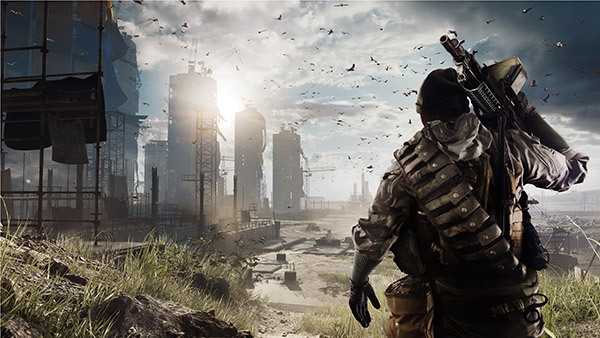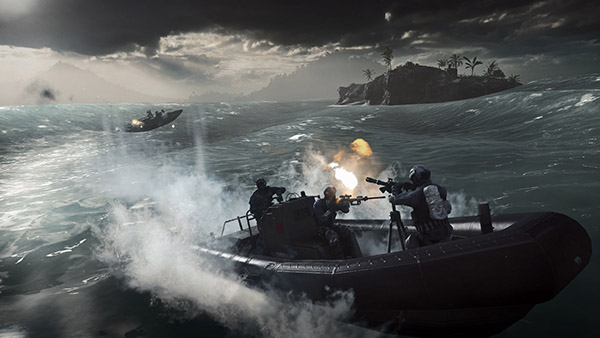DICE's Johan Andersson Talks BF4, Frostbite, Mantle, The Future
Tom's Hardware's Editorial Director, Chris Angelini, sits down with DICE's Johan Andersson to talk about Battlefield 4, the Frostbite 3 engine, features he wants to see in next-gen hardware, developing for the Xbox One and PS4, and AMD's Mantle API.
Preparing For A World Of VR And HMDs
Chris: Right, very cool. In that same forward-looking thread, is there any work that you’ve had to do to prepare or enable Frostbite games for this world that we’re coming up on that's eager to explore head-mounted displays and virtual reality.
Johan: We’re sort of only started getting our feet wet there a little bit and trying out various types of scenarios within our games. There's a lot of people in our multiple game teams here at EA that are excited with VR and HMD type of devices. Also, a little bit, it's difficult to say exactly how our games would be playable with them. Some games fit very well and some you may have a very different type of game play experiences, but usually the experience overall of just exploring a battlefield world with a VR device is actually really quite compelling.
Chris: Yeah.
Johan: We have found a lot of parallelism on the CPU side, which helps a lot because you need to render two views and you need to render the absolute highest frame rate, but most importantly, at very, very low latency. We haven’t done too much work on the latency side, but we've done a lot of work on the performance side. Both in general in the engine, so it's not specific for VR, but it still tremendously benefits VR. I think that's sort of the main area we've been focusing on and we've been running tests with the various APIs and systems out there, just to sort of enable our content creators our game teams to be able to play with it and not be bottlenecked by, okay the engine does not support this so we can't try it, but now we actually have more components working with it. The game creators can try things out and think of the problems from there. There's a lot of difficult challenges, like what do you do with your first-person animation and things like that. We haven’t really thought about it too much yet. That's a lot of work just with your ordinary rendering, but VR it can be from any perspective.
Chris: Right.
Johan: We've been focusing on the engine side mostly just to enable the rest of the game teams to use these things and for focusing on optimization.
Chris: And so knowing the dependencies of those types of environments do you anticipate other developers that don’t have access to as scalable of an engine might encounter difficulty or compatibility issues with them?
Get Tom's Hardware's best news and in-depth reviews, straight to your inbox.
Johan: Yeah, I think it will be difficult to just take a standard game that you have and then just bring it over. If you don’t have the performance sure you may be able to prove out like some of the core animation things, but perhaps not the full gameplay. There could be a little bit of a challenge there.
On the other hand, it can actually be a benefit if you're like a small indie developer and you're just starting from scratch and building something and targeting VR...I'm not sure if there are any games like that, there probably are. Just not having the sort of legacy of this big established ways of making games can probably be really quite refreshing there. Sure you could do things like that with Frostbite also, having just a big engine and then you do a very different type of game. We’ll see what we do in the future there. I think it will be quite exciting regardless.
Current page: Preparing For A World Of VR And HMDs
Prev Page The Future Of Hardware And Game Realism Next Page The Future Of Frostbite: More Streamlined Development-
DanglingPointer I can't wait till this game is on Linux with proper fully baked FGLRX drivers and Mantle on Linux!Reply
Come on AMD! Bring it already!!!! SteamMachines are around the corner! -
vaughn2k Yeah, it seems like him... but I am skeptic, if he could do a bad ass soldier though.. ;)Reply -
cats_Paw Very low quality Interview. All questions are made in a way so that Johan Andersson can promote their company and their games. There is not a single question about something meaningfull to the comunity. Its all like:Reply
-Your game is good in this?
-Yes our game is good in this becouse .
Just the phrasing and the form changes.
At least the users in tomshardware can still offer some solid information. And later people dont understand why 80% of the readers automaticly jump to user comments before reading the full article. -
bemused_fred "Sure we did still have to do a little bit of a compromise on the solution. We're not running at the full native 1080p; we’re running a little bit lower resolution than that."Reply
Good lord! The PS4 can't even run Battlefield 4, a launch title, at 1080p? Where will these consoles be in 5 years time?!?! -
tomfreak Reply
Gulf town or Any 6 core Intel CPU will be the next QX9650, after 5-8years and will still be kicking ass.12087857 said:"Sure we did still have to do a little bit of a compromise on the solution. We're not running at the full native 1080p; we’re running a little bit lower resolution than that."
Good lord! The PS4 can't even run Battlefield 4, a launch title, at 1080p? Where will these consoles be in 5 years time?!?!
May be spending $500-600 on a CPU + a 5years warranty reliable Asus Sabertooth X79 isnt a bad investment. lol
-
ikefu Reply12087857 said:Good lord! The PS4 can't even run Battlefield 4, a launch title, at 1080p? Where will these consoles be in 5 years time?!?!
Its still early in the console cycle and devs will need time to fully unlock them. With the semi heterogeneous architectures of the new consoles its going to be a steep learning curve to figure out the best ways to utilize GPU compute power. They talk about having the CPU at 95% utilization but just because its busy doesn't mean its efficient. Busy is easy to achieve, efficiency is not. There's a lot of room to grow yet.
That plus I don't think most exclusive console gamers are really worried about 1080p (other than a random number in a vacuum that seems bigger than other random numbers). If they were truly worried about resolution they'd be on a PC. The games are still prettier than a 360/PS3 so they'll be happy in the end.
-
cypeq Reply12087857 said:"Sure we did still have to do a little bit of a compromise on the solution. We're not running at the full native 1080p; we’re running a little bit lower resolution than that."
Good lord! The PS4 can't even run Battlefield 4, a launch title, at 1080p? Where will these consoles be in 5 years time?!?!
Frostbite is probably most demanding engine out there... check if your PC can run BF4 at min. 60 FPS in high details @ 1080p. There are many that can't.
Next gen consoles are speced like mediocre gaming PC of today. WTH you expect.
In near future programmers will be able to squeeze bit more juice of them because of more unified and exposed hardware but that's all.
Performance and Quality is on PC. -
deejaybos Yeah, the game looks amazing, then it crashes randomly. Then you play it a little, then it crashes. Then in single player it crashes, then during a map change it crashes, then when someone blows something up somewhere else on the map, it crashes. Guess they forgot to mention the terrible release they've had and the lack of support or acknowledgement. Unless of course you count double XP and a pistol attachment, "acknowledgement".Reply


